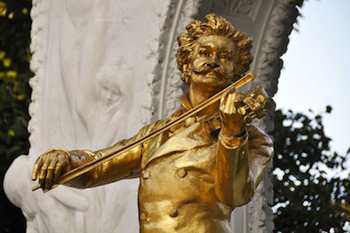- MENU
- HOME
- SEARCH
- WORLD
- MAIN
- AFRICA
- ASIA
- BALKANS
- EUROPE
- LATIN AMERICA
- MIDDLE EAST
- United Kingdom
- United States
- Argentina
- Australia
- Austria
- Benelux
- Brazil
- Canada
- China
- France
- Germany
- Greece
- Hungary
- India
- Indonesia
- Ireland
- Israel
- Italy
- Japan
- Korea
- Mexico
- New Zealand
- Pakistan
- Philippines
- Poland
- Russia
- South Africa
- Spain
- Taiwan
- Turkey
- USA
- BUSINESS
- WEALTH
- STOCKS
- TECH
- HEALTH
- LIFESTYLE
- ENTERTAINMENT
- SPORTS
- RSS
- iHaveNet.com: Travel
By Rick Steves

Johann Strauss Statue
This famous golden statue of Johann Strauss with his violin sits outside the Kursalon in Vienna's City Park
Vienna is a city with a rich culture you can almost inhale and a vivid history you can practically touch. As I walked out of my hotel on a Sunday morning, I decided to skip the sights and immerse myself in Vienna's wealth of cultural offerings.
I kicked off my day with Mass at the Hofburg Palace's Imperial Music Chapel, where the Vienna Boys' Choir sings each Sunday morning throughout their season. I didn't actually see the boys -- no one in the church did -- as they sang like angels from the loft in the rear. But, just like you don't need to see the sun to know it's there on a gorgeous day, you don't need to watch the boys to enjoy their delicately beautiful music. Their voices blended perfectly with the scene in front of us: sunlight streaming through the windows, making it seem as if the Baroque starburst of gilded statuary was bursting over the altar.
Energized, I ducked through a royal passageway to see a performance of the much-loved Lipizzaner stallions at the
As I watched the stallions prance to classical music under lavish chandeliers, it occurred to me that they move in 4:4, not 3:4 time -- even though this is the city of waltz. From my 25-euro ($35) standing-room spot, I realized I was enjoying the show as much -- and with a view just as good -- as those who booked more expensive seats months in advance.
After the show, I strolled about 100 yards to the
I headed to the Burggarten for lunch. Once the backyard of the Hofburg, the Burggarten is now a grassy people's park. After eating lunch under the palm trees in the emperors' conservatory (at
Another ritual is a stop at
Not only did Vienna host some of the greatest (or evil) thinkers of the time, but it was also home to many famous composers -- from Beethoven, walking lost in musical thought through the Vienna Woods, to "Waltz King" Johann Strauss, who kept Vienna's 300 ballrooms spinning during the city's 19th-century belle epoque.
This musical tradition continues into modern times. Even now, you'll find melodic treats wherever you turn. For instance, at the Kursalon, in Vienna's City Park, you can enjoy crowd-pleasing Strauss concerts featuring a mix of ballet, waltzes, and a 15-piece orchestra. The tradition goes back more than a century, when Strauss himself directed concerts in the very same building.
The Vienna Opera is arguably the world's greatest. Even if you don't have time or money for a performance, a visit here is a must. Built in the 1860s, the sumptuous opera house is the pride of Vienna. You can simply admire the Neo-Renaissance building from the outside or take a guided tour of the grand interior, with its chandeliered lobby and carpeted staircases.
On this particular Sunday, the Opera was doing an afternoon performance of Richard Wagner's Tannhuuser. Not wanting to splurge on a ticket, I decided to join the throngs of people outside the opera house, where the performance was to be projected live on a huge screen. Awaiting the start of Tannhuuser, I marveled at how accessible all this was. Two musical Masses and this opera experience -- free. Horses -- $35. Butterflies -- $8. Lunch under the palms -- $20. Coffee and cake -- $7. Seventy bucks in all -- not bad for a day of cultural indulgence.
© RICK STEVES DISTRIBUTED BY TRIBUNE MEDIA SERVICES, INC.
AUTOS | HOBBIES | EDUCATION | FAMILY | FASHION | FOOD & RECIPES | HOME DECOR | RELATIONSHIPS | PARENTING | PETS | TRAVEL | WOMEN
Travel | Sunday Morning: Vienna-Style